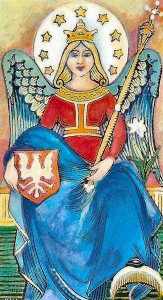Tarot Cards History
 There are hundreds of books written on the Tarot’s her/history and it is in this realm where you’ll find the most controversy. Some early Tarotists postulated that the tarot was introduced at a religious studies international conference in the 13th century to act as a visual aid among attendees to communicate and grasp universal religious teachings.
There are hundreds of books written on the Tarot’s her/history and it is in this realm where you’ll find the most controversy. Some early Tarotists postulated that the tarot was introduced at a religious studies international conference in the 13th century to act as a visual aid among attendees to communicate and grasp universal religious teachings.
The Tarot was designed as a universal depiction of religious concepts shared alike across many religious disciplines. Because all attendees present spoke different languages and the concepts were complex to convey in simple language, illustrations were adopted as a solution. Pictures are worth a thousand words after all.
There is no her/historical proof that this hypothesis is true.
What is known is that the first Tarot deck appeared in the western world in the late 14th– early 15th century in Italy. It was used to play a card game called, Tarochi. Following a strict dictate from the Catholic Church, decks were burned and resurfaced a couple of centuries later in France.
An accultist/alchemist believed he was looking at a mystical object and proceeded to interpret the deck’s colourful symbols. Many throughout the years picked up the challenge and continued to interpret the deck’s cards and symbols from a mystical and divination perspective. Napoleon’s wife, Josephine for example, learned the meanings of the cards and read them for herself (and probably a few friends!) for the purpose of insight and prophecy.
Tarot Reading History
It’s hard to believe that the cards were designed for the sole purpose of card games. Once you learn the symbols on the cards and have used them for a while as a divination tool, it seems unlikely that someone went to so much trouble and expense to create these obviously complex and symbolic cards for a simple game. The truth really is that no one knows where or when they were created.

There are records of a wealthy family discovering them and commissioning a deck of their own created; such as, the aristocratic Visconti family who had portraits of family members placed in certain cards such as the High Priestess.
A comprehensive, documented, provable history doesn’t exist leaving this aspect of the Tarot open to speculation, interpretation, imaginings and life long pursuits.

